
Pesticide application
Encyclopedia
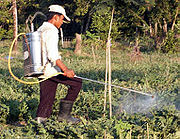

Pesticide
Pesticides are substances or mixture of substances intended for preventing, destroying, repelling or mitigating any pest.A pesticide may be a chemical unicycle, biological agent , antimicrobial, disinfectant or device used against any pest...
s, (including herbicide
Herbicide
Herbicides, also commonly known as weedkillers, are pesticides used to kill unwanted plants. Selective herbicides kill specific targets while leaving the desired crop relatively unharmed. Some of these act by interfering with the growth of the weed and are often synthetic "imitations" of plant...
s, fungicide
Fungicide
Fungicides are chemical compounds or biological organisms used to kill or inhibit fungi or fungal spores. Fungi can cause serious damage in agriculture, resulting in critical losses of yield, quality and profit. Fungicides are used both in agriculture and to fight fungal infections in animals...
s, insecticide
Insecticide
An insecticide is a pesticide used against insects. They include ovicides and larvicides used against the eggs and larvae of insects respectively. Insecticides are used in agriculture, medicine, industry and the household. The use of insecticides is believed to be one of the major factors behind...
s, or nematode
Nematode
The nematodes or roundworms are the most diverse phylum of pseudocoelomates, and one of the most diverse of all animals. Nematode species are very difficult to distinguish; over 28,000 have been described, of which over 16,000 are parasitic. It has been estimated that the total number of nematode...
control agents) are delivered to their biological targets (e.g. pest organism, crop
Crop
Crop may refer to:* Crop, a plant grown and harvested for agricultural use* Crop , part of the alimentary tract of some animals* Crop , a modified whip used in horseback riding or disciplining humans...
or other plant). Public concern about the use of pesticides has high-lighted the need to make this process as efficient as possible, in order to minimise their release into the environment and human exposure (including operators, bystanders and consumers of produce). The practice of pest management by the rational application of pesticides is supremely multi-disciplinary, combining many aspects of biology
Biology
Biology is a natural science concerned with the study of life and living organisms, including their structure, function, growth, origin, evolution, distribution, and taxonomy. Biology is a vast subject containing many subdivisions, topics, and disciplines...
and chemistry
Chemistry
Chemistry is the science of matter, especially its chemical reactions, but also its composition, structure and properties. Chemistry is concerned with atoms and their interactions with other atoms, and particularly with the properties of chemical bonds....
with: agronomy
Agronomy
Agronomy is the science and technology of producing and using plants for food, fuel, feed, fiber, and reclamation. Agronomy encompasses work in the areas of plant genetics, plant physiology, meteorology, and soil science. Agronomy is the application of a combination of sciences like biology,...
, engineering
Engineering
Engineering is the discipline, art, skill and profession of acquiring and applying scientific, mathematical, economic, social, and practical knowledge, in order to design and build structures, machines, devices, systems, materials and processes that safely realize improvements to the lives of...
, meteorology
Meteorology
Meteorology is the interdisciplinary scientific study of the atmosphere. Studies in the field stretch back millennia, though significant progress in meteorology did not occur until the 18th century. The 19th century saw breakthroughs occur after observing networks developed across several countries...
, socio-economics and public health
Public health
Public health is "the science and art of preventing disease, prolonging life and promoting health through the organized efforts and informed choices of society, organizations, public and private, communities and individuals" . It is concerned with threats to health based on population health...
, together with newer disciplines such as biotechnology
Biotechnology
Biotechnology is a field of applied biology that involves the use of living organisms and bioprocesses in engineering, technology, medicine and other fields requiring bioproducts. Biotechnology also utilizes these products for manufacturing purpose...
and information science
Information science
-Introduction:Information science is an interdisciplinary science primarily concerned with the analysis, collection, classification, manipulation, storage, retrieval and dissemination of information...
.
Seed treatments
Seed treatmentSeed treatment
In agriculture, a seed treatment or seed dressing is a chemical, typically antimicrobial or fungidal, with which seeds are treated prior to planting...
s can achieve exceptionally high efficiencies, in terms of effective dose-transfer to a crop. Pesticides are applied to the seed prior to planting, in the form of a seed treatment, or coating
Coating
Coating is a covering that is applied to the surface of an object, usually referred to as the substrate. In many cases coatings are applied to improve surface properties of the substrate, such as appearance, adhesion, wetability, corrosion resistance, wear resistance, and scratch resistance...
, to protect against soil-borne risks to the plant; additionally, these coatings can provide supplemental chemicals and nutrients designed to encourage growth. A typical seed coating can include a nutrient layer—containing nitrogen
Nitrogen
Nitrogen is a chemical element that has the symbol N, atomic number of 7 and atomic mass 14.00674 u. Elemental nitrogen is a colorless, odorless, tasteless, and mostly inert diatomic gas at standard conditions, constituting 78.08% by volume of Earth's atmosphere...
, phosphorus
Phosphorus
Phosphorus is the chemical element that has the symbol P and atomic number 15. A multivalent nonmetal of the nitrogen group, phosphorus as a mineral is almost always present in its maximally oxidized state, as inorganic phosphate rocks...
, and potassium
Potassium
Potassium is the chemical element with the symbol K and atomic number 19. Elemental potassium is a soft silvery-white alkali metal that oxidizes rapidly in air and is very reactive with water, generating sufficient heat to ignite the hydrogen emitted in the reaction.Potassium and sodium are...
, a rhizobia
Rhizobia
Rhizobia are soil bacteria that fix nitrogen after becoming established inside root nodules of legumes . Rhizobia require a plant host; they cannot independently fix nitrogen...
l layer—containing symbiotic
Symbiosis
Symbiosis is close and often long-term interaction between different biological species. In 1877 Bennett used the word symbiosis to describe the mutualistic relationship in lichens...
bacteria
Bacteria
Bacteria are a large domain of prokaryotic microorganisms. Typically a few micrometres in length, bacteria have a wide range of shapes, ranging from spheres to rods and spirals...
and other beneficial microorganisms, and a fungicide (or other chemical) layer to make the seed less vulnerable to pests.
Spray application
One of the more common forms of pesticide application, especially in conventional agriculture, is the use of mechanical sprayerSprayer
A sprayer is a device used to spray a liquid.In agriculture, a sprayer is a piece of equipment that spray nozzles to apply herbicides, pesticides, and fertilizers to agricultural crops...
s. Hydraulic sprayers consists of a tank
Tank
A tank is a tracked, armoured fighting vehicle designed for front-line combat which combines operational mobility, tactical offensive, and defensive capabilities...
, a pump
Pump
A pump is a device used to move fluids, such as liquids, gases or slurries.A pump displaces a volume by physical or mechanical action. Pumps fall into three major groups: direct lift, displacement, and gravity pumps...
, a lance (for single nozzles) or boom, and a nozzle (or multiple nozzles). Sprayers convert a pesticide formulation
Pesticide formulation
The biological activity of a pesticide, be it chemical or biological in nature, is determined by its active ingredient . Pesticide products very rarely consist of pure technical material. The AI is usually formulated with other materials and this is the product as sold, but it may be further...
, often containing a mixture of water (or another liquid chemical carrier, such as fertilizer) and chemical, into droplets, which can be large rain-type drops or tiny almost-invisible particles. This conversion is accomplished by forcing the spray mixture through a spray nozzle
Spray nozzle
A spray nozzle is a precision device that facilitates dispersion of liquid into a spray. Nozzles are used for three purposes: to distribute a liquid over an area, to increase liquid surface area, and create impact force on a solid surface...
under pressure. The size of droplets can be altered through the use of different nozzle sizes, or by altering the pressure under which it is forced, or a combination of both. Large droplets have the advantage of being less susceptible to spray drift, but require more water per unit of land covered. Due to static electricity, small droplets are able to maximize contact with a target organism, but very still wind conditions are required.
Spraying pre- and post-emergent crops
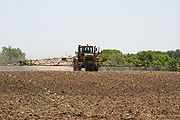
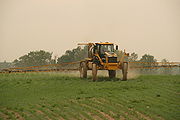
Germination
Germination is the process in which a plant or fungus emerges from a seed or spore, respectively, and begins growth. The most common example of germination is the sprouting of a seedling from a seed of an angiosperm or gymnosperm. However the growth of a sporeling from a spore, for example the...
status of the plant. Pre-emergent pesticide application, in conventional agriculture, attempts to reduce competitive pressure on newly germinated plants by removing undesirable organisms and maximizing the amount of water, soil nutrients, and sunlight available for the crop. An example of pre-emergent pesticide application is atrazine
Atrazine
Atrazine, 2-chloro-4--6--s-triazine, an organic compound consisting of an s-triazine-ring is a widely used herbicide. Its use is controversial due to widespread contamination in drinking water and its associations with birth defects and menstrual problems when consumed by humans at concentrations...
application for corn
Maize
Maize known in many English-speaking countries as corn or mielie/mealie, is a grain domesticated by indigenous peoples in Mesoamerica in prehistoric times. The leafy stalk produces ears which contain seeds called kernels. Though technically a grain, maize kernels are used in cooking as a vegetable...
. Similarly, glyphosate mixtures are often applied pre-emergent on agricultural fields to remove early-germinating weeds and prepare for subsequent crops. Pre-emergent application equipment often has large, wide tires designed to float on soft soil, minimizing both soil compaction and damage to planted (but not yet emerged) crops. A three-wheel application machine, such as the one pictured on the right, is designed so that tires do not follow the same path, minimizing the creation of ruts in the field and limiting sub-soil damage.
Post-emergent pesticide application requires the use of specific chemicals chosen minimize harm to the desirable target organism. An example is 2,4-Dichlorophenoxyacetic acid
2,4-Dichlorophenoxyacetic acid
2,4-Dichlorophenoxyacetic acid is a common systemic pesticide/herbicide used in the control of broadleaf weeds. It is the most widely used herbicide in the world, and the third most commonly used in North America...
, which will injure broadleaf weed
Weed
A weed in a general sense is a plant that is considered by the user of the term to be a nuisance, and normally applied to unwanted plants in human-controlled settings, especially farm fields and gardens, but also lawns, parks, woods, and other areas. More specifically, the term is often used to...
s (dicots) but leave behind grass
Grass
Grasses, or more technically graminoids, are monocotyledonous, usually herbaceous plants with narrow leaves growing from the base. They include the "true grasses", of the Poaceae family, as well as the sedges and the rushes . The true grasses include cereals, bamboo and the grasses of lawns ...
es (monocots). Such a chemical has been used extensively on wheat
Wheat
Wheat is a cereal grain, originally from the Levant region of the Near East, but now cultivated worldwide. In 2007 world production of wheat was 607 million tons, making it the third most-produced cereal after maize and rice...
crops, for example. A number of companies have also created genetically-modified organisms that are resistant to various pesticides. Examples include glyphosate-resistant soybeans and Bt maize, which change the types of formulations involved in addressing post-emergent pesticide pressure. It is important to also note that even given appropriate chemical choices, high ambient temperatures or other environmental influences, can allow the non-targeted desirable organism to be damaged during application. As plants have already germinated, post-emergent pesticide application necessitates limited field contact in order to minimize losses due to crop and soil damage. Typical industrial application equipment will utilize very tall and narrow tires and combine this with a sprayer body which can be raised and lowered depending on crop height. These sprayers usually carry the label ‘high-clearance’ as they can rise over growing crops, although usually not much more than 1 or 2 meters high. In addition, these sprayers often have very wide booms in order to minimize the number of passes required over a field, again designed to limit crop damage and maximize efficiency. In industrial agriculture
Industrial agriculture
Industrial farming is a form of modern farming that refers to the industrialized production of livestock, poultry, fish, and crops. The methods of industrial agriculture are technoscientific, economic, and political...
, spray booms 120 feet (40 meters) wide are not uncommon, especially in prairie agriculture with large, flat fields. Related to this, aerial pesticide application
Aerial application
Aerial application, commonly called crop dusting, involves spraying crops with fertilizers, pesticides, and fungicides from an agricultural aircraft. The specific spreading of fertilizer is also known as aerial topdressing....
is a method of top dressing a pesticide to an emerged crop which eliminates physical contact with soil and crops.
Air Blast sprayers, also known as air-assisted or mist sprayers, are often used for tall crops, such as tree fruit, where boom sprayers and aerial application would be ineffective. These types of sprayers can only be used where overspray—spray drift—is less of a concern, either through the choice of chemical which does not have undesirable effects on other desirable organisms, or by adequate buffer distance. These can be used for insects, weeds, and other pests to crops, humans, and animals. Air blast sprayers inject liquid into a fast-moving stream of air, breaking down large droplets into smaller particles by introducing a small amount of liquid into a fast-moving stream of air.
Fogger
Fogger
A fogger is any device that creates a fog, typically containing an insecticide for killing insects and other arthropods. Foggers are often used by consumers as a low cost alternative to professional pest control services. The number of foggers needed for pest control depends on the size of the...
s fulfill a similar role to mist sprayers in producing particles of very small size, but use a different method. Whereas mist sprayers create a high-speed stream of air which can travel significant distances, foggers use a piston or bellows to create a stagnant area of pesticide that is often used for enclosed areas, such as houses and animal shelters.
Spraying inefficiencies
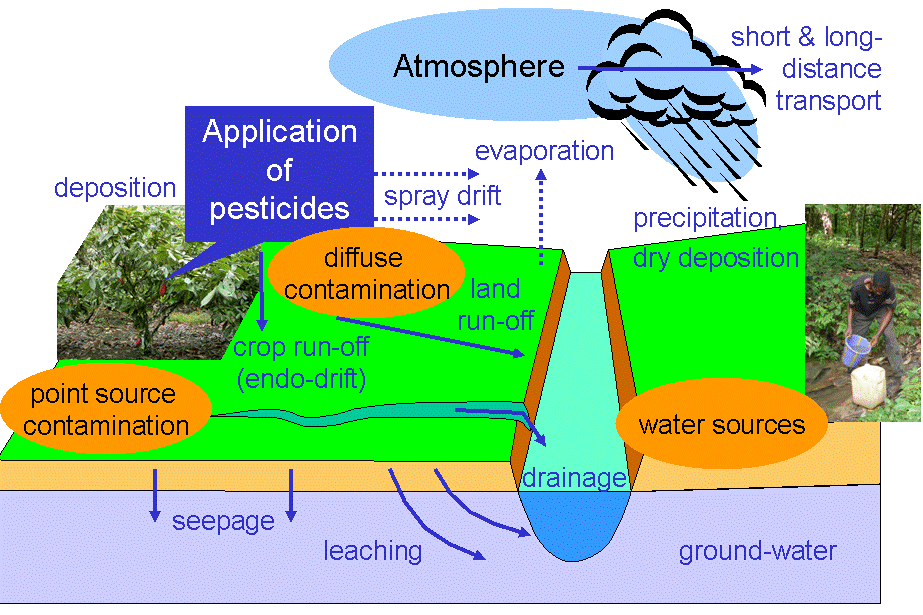
Historically, dose-transfer to the biological target (i.e. the pest) has been shown to be inefficient. However, relating "ideal" deposits with biological effect is fraught with difficulty), but in spite of Hislop’s misgivings about detail, there have been several demonstrations that massive amounts of pesticides are wasted by run-off from the crop and into the soil, in a process called endo-drift. This is a less familiar form of pesticide drift, with exo-drift causing much greater public concern. Pesticides are conventionally applied using hydraulic atomisers, either on hand-held sprayers or tractor booms, where formulations are mixed into high volumes of water.
Different droplet sizes have dramatically different dispersal characteristics, and are subject to complex macro- and micro-climatic interactions (Bache & Johnstone, 1992). Greatly simplifying these interactions in terms of droplet size and wind speed, Craymer & Boyle concluded that there are essentially three sets of conditions under which droplets move from the nozzle to the target. These are where:
- sedimentation dominates: typically larger (>100 µm) droplets applied at low wind-speeds; droplets above this size are appropriate for minimising drift contamination by herbicides.
- turbulent eddies dominate: typically small droplets (<50 µm) that are usually considered most appropriate for targeting flying insects, unless an electrostatic charge is also present that provides the necessary force to attract droplets to foliage. (NB: the latter effects only operate at very short distances, typically under 10 mm.)
- intermediate conditions where both sedimentation and drift effects are important. Most agricultural insecticide and fungicide spraying is optimised by using relatively small (say 50-150 µm) droplets in order to maximize “coverage” (droplets per unit area), but are also subject to drift.
Improved targeting
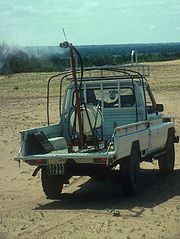
Ultra-low volume
The term Ultra-Low Volume is used in the context of pesticide application.Ultra-low volume application of pesticides has been defined as spraying at a of les than 5 L/ha for field crops or les than 50 L/ha for tree/bush crops...
(ULV) or very low volume (VLV) application rates of pesticidal mixtures can achieve similar (or sometimes better) biological results by improved timing and dose-transfer to the biological target (i.e. pest). No atomizer has been developed able to produce uniform (monodisperse) droplets, but rotary (spinning disc and cage) atomizers usually produce a more uniform droplet size spectrum than conventional hydraulic nozzles (see: CDA & ULV application equipment). Other efficient application techniques include: banding, baiting, specific granule placement, seed treatments and weed wiping.
CDA is good examples of a rational pesticide use (RPU) technology (Bateman, 2003), but unfortunately has been unfashionable with public funding bodies since the early 1990s, with many believing that all pesticide development should be the responsibility of pesticide manufacturers. On the other hand, pesticide companies are unlikely widely to promote better targeting and thus reduced pesticide sales, unless they can benefit by adding value to products in some other way. RPU contrasts dramatically with the promotion of pesticides, and many agrochemical concerns, have equally become aware that product stewardship provides better long-term profitability than high pressure salesmanship of a dwindling number of new “silver bullet” molecules. RPU may therefore provide an appropriate framework for collaboration between many of the stake-holders in crop protection.
Understanding the biology and life cycle of the pest is also an important factor in determining droplet size. The Agricultural Research Service
Agricultural Research Service
The Agricultural Research Service is the principal in-house research agency of the United States Department of Agriculture . ARS is one of four agencies in USDA's Research, Education and Economics mission area...
, for example, has conducted tests to determine the ideal droplet size of a pesticide used to combat corn earworm
Helicoverpa zea
The larva of the moth Helicoverpa zea is a major agricultural pest. It can feed on many different plants during the larval stage. Accordingly, the species has been given many different common names. When the larva consumes cotton, it is known as the cotton bollworm...
s. They found that in order to be effective, the pesticide needs to penetrate through the corn’s silk, where the earworm’s larvae hatch. The research concluded that larger pesticide droplets best penetrated the targeted corn silk. Knowing where the pest's destruction originates is crucial in targeting the amount of pesticide needed.
Quality and Assessment of Equipment
Ensuring quality of sprayers by testing and setting of standards for application equipment is important to ensure users get value for money. Since most equipment uses various hydraulic nozzles, various initiatives have attempted to classify spray quality, starting with the BCPC system .Other application methods
Aerial application
See: aerial spraying, Ultra-low volumeUltra-low volume
The term Ultra-Low Volume is used in the context of pesticide application.Ultra-low volume application of pesticides has been defined as spraying at a of les than 5 L/ha for field crops or les than 50 L/ha for tree/bush crops...
spray application, crop dusting
Application methods for household insecticides
Pest management in the home begins with restricting the availability to insects of three vital commodities: shelter, water and food. If insects become a problem despite such measures, it may become necessary to control them using chemical methods, targeting the active ingredientActive ingredient
An active ingredient is the substance of a pharmaceutical drug or a pharmaceutical ingredient and bulk active in medicine; in pesticide formulations active substance may be used. Some medications and pesticide products may contain more than one active ingredient...
to the particular pest.
Insect repellent
Insect repellent
An insect repellent is a substance applied to skin, clothing, or other surfaces which discourages insects from landing or climbing on that surface. There are also insect repellent products available based on sound production, particularly ultrasound...
, referred to as "bug spray", comes in a plastic
Plastic
A plastic material is any of a wide range of synthetic or semi-synthetic organic solids used in the manufacture of industrial products. Plastics are typically polymers of high molecular mass, and may contain other substances to improve performance and/or reduce production costs...
bottle or aerosol
Aerosol spray
Aerosol spray is a type of dispensing system which creates an aerosol mist of liquid particles. This is used with a can or bottle that contains a liquid under pressure. When the container's valve is opened, the liquid is forced out of a small hole and emerges as an aerosol or mist...
can. Applied to clothing, arms, legs, and other extremities, the use of these products will tend to ward off nearby insects. This is not an insecticide.
Insecticide used for killing pests
Pest (animal)
A pest is an animal which is detrimental to humans or human concerns. It is a loosely defined term, often overlapping with the related terms vermin, weeds, parasites and pathogens...
—most often insect
Insect
Insects are a class of living creatures within the arthropods that have a chitinous exoskeleton, a three-part body , three pairs of jointed legs, compound eyes, and two antennae...
s, and arachnid
Arachnid
Arachnids are a class of joint-legged invertebrate animals in the subphylum Chelicerata. All arachnids have eight legs, although in some species the front pair may convert to a sensory function. The term is derived from the Greek words , meaning "spider".Almost all extant arachnids are terrestrial...
s—primarily comes in an aerosol can, and is sprayed directly on the insect or its nest as a means of killing it. Fly sprays will kill house flies, blowflies, ant
Ant
Ants are social insects of the family Formicidae and, along with the related wasps and bees, belong to the order Hymenoptera. Ants evolved from wasp-like ancestors in the mid-Cretaceous period between 110 and 130 million years ago and diversified after the rise of flowering plants. More than...
s, cockroach
Cockroach
Cockroaches are insects of the order Blattaria or Blattodea, of which about 30 species out of 4,500 total are associated with human habitations...
es and other insect
Insect
Insects are a class of living creatures within the arthropods that have a chitinous exoskeleton, a three-part body , three pairs of jointed legs, compound eyes, and two antennae...
s and also spider
Spider
Spiders are air-breathing arthropods that have eight legs, and chelicerae with fangs that inject venom. They are the largest order of arachnids and rank seventh in total species diversity among all other groups of organisms...
s. Other preparations are granules or liquids that are formulated with bait that is eaten by insects. For many household pests bait traps are available that contain the pesticide and either pheromone or food baits. Crack and crevice sprays are applied into and around openings in houses such as baseboards and plumbing. Pesticides to control termites are often injected into and around the foundations of homes.
Active ingredients of many household insecticides include permethrin
Permethrin
Permethrin is a common synthetic chemical, widely used as an insecticide, acaricide, and insect repellent. It belongs to the family of synthetic chemicals called pyrethroids and functions as a neurotoxin, affecting neuron membranes by prolonging sodium channel activation. It is not known to...
and tetramethrin
Tetramethrin
Tetramethrin is a potent synthetic insecticide in the pyrethroid family. It is a white crystalline solid with a melting point of 65-80 °C. The commercial product is a mixture of stereoisomers....
, which act on the nervous system of insects and arachnids.
Bug sprays should be used in well ventilated areas only, as the chemicals contained in the aerosol and most insecticides can be harmful or deadly to humans and pets. All insecticide products including solids, baits and bait traps should be applied such that they are out of reach of wildlife, pets and children.
Historical equipment and techniques
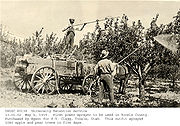
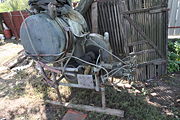
See also
- aerial applicationAerial applicationAerial application, commonly called crop dusting, involves spraying crops with fertilizers, pesticides, and fungicides from an agricultural aircraft. The specific spreading of fertilizer is also known as aerial topdressing....
- Aerosol sprayAerosol sprayAerosol spray is a type of dispensing system which creates an aerosol mist of liquid particles. This is used with a can or bottle that contains a liquid under pressure. When the container's valve is opened, the liquid is forced out of a small hole and emerges as an aerosol or mist...
- FormulationPesticide formulationThe biological activity of a pesticide, be it chemical or biological in nature, is determined by its active ingredient . Pesticide products very rarely consist of pure technical material. The AI is usually formulated with other materials and this is the product as sold, but it may be further...
- Integrated pest managementIntegrated Pest ManagementIntegrated pest management is an ecological approach to agricultural pest control that integrates pesticides/herbicides into a management system incorporating a range of practices for economic control of a pest...
(IPM) - Pest controlPest controlPest control refers to the regulation or management of a species defined as a pest, usually because it is perceived to be detrimental to a person's health, the ecology or the economy.-History:...
- PesticidePesticidePesticides are substances or mixture of substances intended for preventing, destroying, repelling or mitigating any pest.A pesticide may be a chemical unicycle, biological agent , antimicrobial, disinfectant or device used against any pest...
- InsecticideInsecticideAn insecticide is a pesticide used against insects. They include ovicides and larvicides used against the eggs and larvae of insects respectively. Insecticides are used in agriculture, medicine, industry and the household. The use of insecticides is believed to be one of the major factors behind...
- FungicideFungicideFungicides are chemical compounds or biological organisms used to kill or inhibit fungi or fungal spores. Fungi can cause serious damage in agriculture, resulting in critical losses of yield, quality and profit. Fungicides are used both in agriculture and to fight fungal infections in animals...
- Weed controlWeed controlWeed control is the botanical component of pest control, using physical and chemical methods to stop weeds from reaching a mature stage of growth when they could be harmful to domesticated plants and livestock...
- Pesticide drift
- sprayerSprayerA sprayer is a device used to spray a liquid.In agriculture, a sprayer is a piece of equipment that spray nozzles to apply herbicides, pesticides, and fertilizers to agricultural crops...
- spray nozzleSpray nozzleA spray nozzle is a precision device that facilitates dispersion of liquid into a spray. Nozzles are used for three purposes: to distribute a liquid over an area, to increase liquid surface area, and create impact force on a solid surface...
Further reading
- Matthews G.A, (2000) Pesticide Application Methods 3rd Edition Blackwell, Oxford
- Matthews G.A. (2006) Pesticides: Health, Safety and the Environment Blackwell, Oxford
- Bache D.H., Johnstone, D.R. (1992) Microclimate and spray dispersion Ellis Horwood, Chichester, England.
External links
- International Pesticide Application Research Centre (IPARC)
- Ontario Ministry of Agriculture, Food, and Rural Affairs - Pesticide Storage, Handling, and Application
- Example of Pesticide application in the Tsubo-en Zen garden (Japanese dry rock garden) in Lelystad, The Netherlands.
- Stewardship Community working together to promote the safe, effective use of pesticides.

